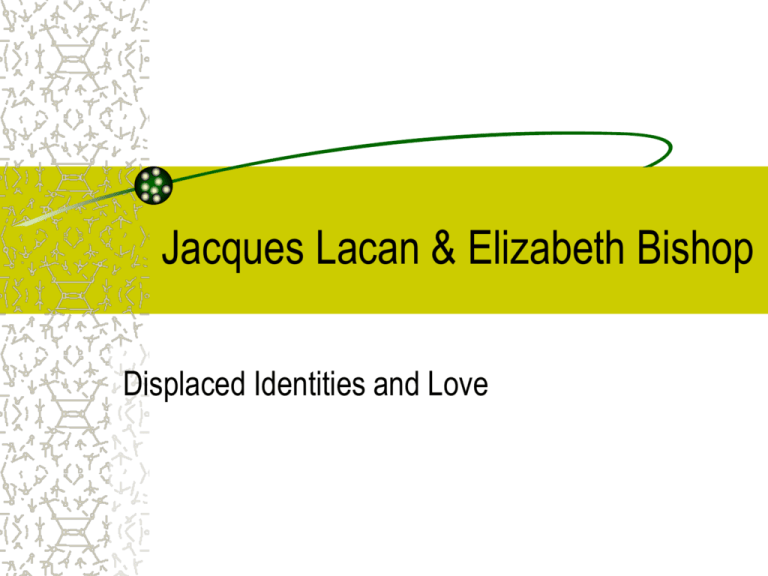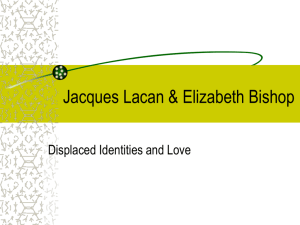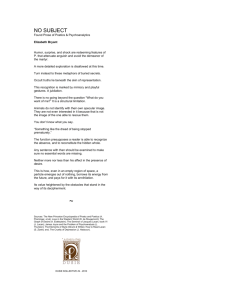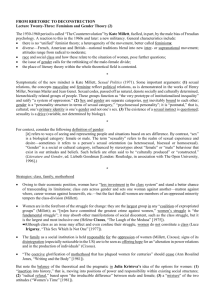
Jacques Lacan & Elizabeth Bishop
Displaced Identities and Love
Outline
Summary: Key Ideas
General Questions
Three Stages of Psychic Development;
– Mirror Stage ,Questions and Examples
– Oedipal Stage
Gender Difference & Language:
–
–
–
–
Questions
Gender Difference
Insatiable Desire *
Questions: about Lacan’s views of love
E. Bishop’s Poetics of Displacement
Next week
Summary of Key Ideas
Chap 3: pp. 61-; chap 4 161- (The Unconscious as language and
Sexual development)
The unconscious is
– structured like a language.
– a constantly moving chain of signifiers (sliding of signifying chain.
The three-part personality (order): The Real, the Imaginary and
the Symbolic, in which we have needs, make demands, and
“Desire.”
Development and splitting of self –mirror stage, self-Other and
subject position, fragmented body.
Gendering process (chap 4) and phallus and love: The Name of
the Father,
General Questions
Your questions? Your Examples?
Do you agree that the Father’s authority is associated
with language and interdiction(禁止)?
Do you agree that our learning of language is a process
of castration and fragmentation (splitting)? And that our
desire is drifting from one object to the next, and that
ultimately we desire a kind of pre-Oedipal unity?
Why are there only ‘signifiers’(意符 [roz]) but not
signified (意旨[the concept of rose]) in the unconscious?
The orders of human existence:
the Imaginary, the Symbolic & the Real
(chap 3: 62-63; chap 4: 164-65)
The Real – pre-linguistic ‘pure plenitude’ (no subjectobject distinction); beyond the Symbolic order (cannot be
talked about).
The imaginary (centering around the Mother) –from bits
and pieces to a sense of unity; (mis)recongnition of
one’s self through an external image; illusory unity with
the mother split from her; fragmentary sense of self
The Symbolic (intervention of the Name of the Father) –
entry into language (a world of difference) a loss of
wholeness, a split in the speaking “I” and spoken “I”
The orders of human existence:
the Imaginary, the Symbolic & the Real
The Real – oneness and jouissance
(undifferentiated unity of the mother,
objects of love, or objet a).
The imaginary (the mirror stage) – two
together and then separate (Baby and the
Mother)
The Symbolic – three: the Father, the
(M)other, and Self
The Mirror Stage
(chap 4: 165)
The baby (with its fragmentary sense of self)
identifies with an external image (of the body
in the mirror or through the mother or primary
caregiver) have a sense of self (ideal ego).
Split:
1) In the self: experiences fragmentation but sees
wholeness;
2) From the self: sees loss in the mirror image
Split Identity in Language
Against Cartesianism (rational
consciousness) and humanism (free will).
–
–
–
“Unconscious is the language of the Other.”
Language speaks us.
I think where I am not . . .(Ego alienated,
not the center of one’s identity.
– Ideal ego (mirror image) ego ideal (role
model)
Review Questions
1. Do you agree that our identity is
fragmentary and why? Which of the
following do you agree with? "I think,
therefore, I am," "Where I think, there I
am," or "I think where I am not,
therefore I am where I do not think."
2. What are the three phases of psychic
development according to Lacan?
3. What is mirror stage? Why is it an
important stage in child development?
Mirror & Identity: Some examples
Vanity: In classical paintings & fairy tales
(actually it implies patriarchy’s repression of
female subjectivity)
e.g. Venus at
her Mirror
by VELÁZQUEZ, Diego Rodriguez
de Silva y (b. 1599, Sevilla, d. 1660,
Madrid)
Uses of Mirror: Some examples
The return/assertion of the repressed:
a. Alter ego (or double)
b. Mirror image as deeper levels of self, or ideal ego.
e.g. 1. 19th century women in Jane Eyre and Wide Sargasso
Sea (textbook chap 4 166-69) – alter ego
e.g. 2. chap 4 (176-77)The Awakening; “The Yellow
Wallpaper”
Mother and Daugher in
The Piano
Uses of Mirror: Some examples
3. Looking at the mirror: changing one’s ideal ego or
discovering one’s selves. (Piano/French Lieutenant’s
Woman)
Mirror Image & Double: extensions
We—esp. women-- are always conscious of our mirror
images, or looking for screen images for selfidentification.
What’s projected on the mirror: The Other, either ideal
ego or the repressed.
– e.g. Jane/Antoinette; movie stars as the phallic symbol
– The magical and the “uncanny”? “Mirror, Mirror on the wall”
psychological roots: the strangest // the most
familiar (homely, unhomely)
The Oedipal Stage and
the Symbolic Order
Second-stage split desire for the mother sublimated
into desire for the unattainable “Other”
Recognize the Name of the Father. (textbook chap 3:
63; chap 4: 164)
– Language as a system of difference (with no essential or
unchanged meanings) (chap 4: p. 171-73; e.g. “woman”
=femininity, fertility, lady, …etc.—all signifiers)
– the signified get repressed beyond recognition
S-ier
-----S-ied
The self, the other, the Other
(Lacan’s Schema L –revision of F’s triangle)
Id
(man in the realm of ‘the Real’)
2. Interactions
of different
forces in the
psyche
Ego
the other
(e.g. mother,mirror image)
1. From The
Mirror Stage to
Oedipal stage
and after
the Other (Father)
the Other
The Other is embodied in the figure of the
symbolic father. Its major signifier: the phallus
. . . stands for language and the conventions
of social life organized under the category of
the law. (source)
(different from “the [feminine] Other”—which
is the feminine space on the margin or
outside of the Symbolic– Cf. chap. 4.)
II. Questions
1. Why is gender definition slippery?
2. What is phallus to Lacan? Why
is it “transcendental signifier”?
Do you agree our desire centers
around “being” or “having”
phallus?
3. Why is the unconscious
structured like language?
Causes of Gender Fluidity and Unstable
Self: Slippery Chain of Signification
Meaning of a sign is not in it; rather, it resides in its
difference from the other signs. (textbook chap 3: 62; chap
4: 169)
Sign = signifier (form) + signified (concept; usu. more
than one)
To determine its meaning(黃﹚, we need to look at its
context (its differences from and relation to the signs
around it 黃帝、黃禍、黃狗).
Transcendental signifier: absolute sign whose
meaning(s) does not change in its context; who fixes
the chain of signification. (chap 4: 173)
Gender Difference
Lacan’s analogy of the restroom signs: (chap 4:
171-72)
1.
2.
Arbitrary meaning structure determine gender difference
Slippery chain
3. It speaks man
Phallus vs. Woman as Other
(chap 4: 172-73)
In the Symbolic Order, phallus = wholeness and
power; wholeness hole, in fact, nobody owns
the phallus/power.
Women as Lack, or ‘Other’ which can move
outside of language and be in “jouissance”
(transgressive pleasure)
the unconscious-- structured like
language
supported by F’s view of repression (ideas repressed
as codes)
evidence from Freud’s language of Dream
(condensation, displacement, symbolization);
S/s :
/ = the barrier between the conscious and the
unconscious, which resists being represented; / = the
phallus.
We are conditioned by the Symbolic order.
movement of our desire –like metonymy. (Cf. chap
4: 172)
Insatiable Desire:
Need, Demand, and Desire (1)
(chap 3: 62)
A child develops from need to demand and desire.// its
movement from the Real, to the Imaginary and
Symbolic.
the Real
the Imaginary
The Symbolic
need
demand
desire
Need – requirements for brutal survival.
(e.g. biological need for milk) absence of the mother
the baby’s social, imaginary and linguistic functions
evolve.
Effects of the three orders:
Need, Demand, and Desire (2)
Demand: need formulated in language (with meanings; e.g.
need for breast as good or bad).
-- Demand has two objects: one spoken, the other unspoken.
-- verbalization of imaginary subject-object, self-other relations.
66 (Grosz pp. 59 - 67)
Desire: primally repressed wishes [for unity with the Mother
or for self-confirmation] reappear in and as unconscious
desire.
-- insatiable; characterized by lack. (Grosz pp. 59 - 67)
Desire: expressed as
Demand of Different Objects (e.g. pacifier,
receiving blanket, the mother’s handkerchief,
etc.)
The conflict or gap between one’s demand and
need.
The connection of the desired object and the
demanded: metonymic connection = whole and
parts, or continguity (鄰近).
Questions III
Lacan thinks that both our desire and
demand (for love) are insatiable,
because there is always an
otherness to it which cannot be
represented in language, or because
we ultimately desire an impossible
unity with the lover/Mother.
Do you agree?
Lacan’s Views of Love (1):
a Mirage to Hide the Impossible
Why is there love? Because there is no sexual relationship.
Love is the mirage that fills out the void of the impossibility
of the relationship between the two sexes.
Why impossible? Unity with the other and in one’s self.
Demand = a demand for the unity of the self and the other
“Love consists in a series of …demands for the proof of the
other’s commitment. The proofs sought from the other are
impossible, imaginary tests of love.” (G 132)
The obstacles of love is actually internal, a fact which courtly
or romantic lovers cannot face.
Lacan’s Views of Love (1):
the Impossible
Examples: Woman: conflict between being a sexual
object and a subject demanding recognition.
a.
b.
As a sexual object, she
“paints/shaves/dyes/diets/exercises her body, and clearly
derives pleasure from compliments about her looks. Her
whole body becomes a phallus to compensate for a genital
‘deficiency.’ (G 133)
As subject, she ‘demands’ the man, his attention,
affections, and his capacity to give her identity…
Lacan’s Views of Love (1):
the Impossible
Examples: Man: conflict between desire and affection.
a.
b.
When desiring a woman, he “explores, conquers and
appreciates” her enigma as a phallus, which, once
unveiled, is a lack and confronts the man with his own
castration.
After a period of familiarity, the mystery is gone and the
sexual partner becomes more an object of affection than of
desire. The man then turns to another woman for her
recognition of his having a phallus.
Note: Having phallus and being phallus, places in the circuit of
exchange.
Lacan’s Views of Love (2):
paradoxical fulfillment
For Lacan, love’s sublime moment occurs when the
beloved enacts the metaphor of love, when he substitutes
his position of the lover for that of the beloved object and
starts to act in the same way the lover has so far
acted. . . .it occurs when the beloved returns love by
giving what he does not have.
Beloved, realizing the real object-cause of the other’s
love does not reside in me beloved object (metonymy;
what he does not have; lack) can only return “love”
(Bozovic 69; 77)
Elizabeth Bishop
A victim of her loss & displacement,
Or one who is able to turn it into art?
Elizabeth Bishop:
A Life of Displacement
Displacement in Life:
born in Worcester, Massachusetts in 1911;
her father was dead when she was 8 months old, and
her mother institutionalized when she was five.
Spent her childhood in Nova Scotia with her
grandparents; (clip: 13:40)
Forced to move to Boston, MA to live with her paternal
grandparents. Later rescued by her aunt.
Bishop traveled extensively in Europe and lived in New
York, Key West, Florida, and, for sixteen years, in Brazil
Ref. http://www.youtube.com/watch?v=_SJEylT-4GI 2:50; 5:24
“In the Village” –the scream
A scream, the echo of a scream, hangs over that Nova Scotian
village. No one hears it; it hangs there forever, a slight stain in
those pure blue skies, skies that travelers compare to those of
Switzerland, too dark, too blue, so that they seem to keep on
darkening a little more around the horizon-or is it around the
rims of the eyes?-the color of the cloud of bloom on the elm
trees, the violet on the fields of oats; something darkening over
the woods and waters as well as the sky. The scream hangs
like that, unheard, in memory-in the past, in the present, and
those years between. It was not even loud to begin with,
perhaps. It just came there to live, forever-not loud, just alive
forever. Its pitch would be the pitch of my village. Flick the
lightening rod on top of the church steeple, with your fingernail
and you will hear it.
Elizabeth Bishop: Style
Highly crafted
Displacement as a major theme.
e.g. “One Art” (clip: 11:50) and “Sestina” objectifying
her losses and turn them into recognizable aesthetic
forms (repetition, sestina, metaphor and metonymy).
aestheticization or distanciation as a way of
displacement. This displacement is actively done, but
not permanent.
e.g. the scream “Flick the lighting on top of the church
steeple with your fingernail and you will hear it.”
Cf. textbook (pp. 39 - )
Elizabeth Bishop: a Psychoanalytic
Reading
Cf. textbook (pp. 39 - )
distance and absence disturbs “the child’s sense of
boundaries between subjectivity interiority and objective
exteriority, so that many of the child’s observations are
characterized by crossings—of perceptual and actual
realms, of modes, of being, of metaphoric qualities…
Displacement works along a “metonymic pathway”
From displacement to self-healing
e.g. “Sestina” images of pain, human interactions and
transformation of these images?
Sestina
Sestina: six elements changing
positions—house, grandmother,
child, stove, almanac, tears.
Metaphoric/metonymic chains
Red Stove and Flowers
grandma’s: tears equinoctial(晝夜平
分時的 ) tears almanac tea as
dark brown tears; [moons fall like
tears] sings to the stove (besides
housekeeping)
Child’s: teakettle’s small tears Marvel
Stove rigid house, a man with
The inscription: May the Future's
buttons like tears [moons fall like
Happy Hours /Bring you Beans &
tears] inscrutable house
Rice & Flowers / April 27th, 1955 /
Elizabeth.
“In the Waiting Room”
What kind of identity is constructed by this a six-yearold girl?
How does she establish her identity?
What do the images of volcano and African natives,
as well as all the other images on National
Geographic mean to her?
How about the adults around her? And her aunt?
What is the “big black wave” she is sliding beneath?
“In the Waiting Room”
1.
2.
Thesis: the poem records the speaker’s uncertain entry into society
(and its symbolic order) as a one marginalized because of her
gender and her insecurity.
Not sure about her self; (too shy to stop; dare not look at herself,
cannot look higher); simultaneous self-identification and selfquestioning
Three-stage identification:
1.
2.
3.
internalize the aunt’s pains;
Unable to identify with “the phallus” or symbols of power—boots,
trousers, hands.
Objects of identification—her aunt and hanging breasts
“In the Waiting Room”
The self-construction is uncertain and retains traces of the
maternal Other
–
moving from the exterior to the interior, pushed back to the
exterior only to get back in;
Moving between social order and the black wave
Social order represented by
–
–
•
•
•
•
–
Clear demarcation of place and time;
clothing and boots,
Lamps and magazines;
Social hierarchy implied in the magazine;
The black wave
•
•
Unnamed;
Close to the darkness and coldness outside
“In the Waiting Room”
traces of the maternal Other displaced by the social and
historical world.
– Signs of the maternal:
• The aunt in the clinic; her voice heard (scream)—a
•
voice that could have got louder and worse
Family voice black wave
– vs. what’s seen by Elizabeth and the date of the
first World War
Martin & Osa Johnson
movies of Africa, Borneo, and the South
Seas
Reference
Elizabeth Grosz Jacque Lacan: A Feminist
Introduction
The Other (with a big O)
http://www.mii.kurumeu.ac.jp/~leuers/Lacother.htm
Lacan and Love New Formations 23 (1994).
Next Week
Wide Sargasso Sea (excerpt) by Jean Rhys
Re-read chaps 3 & 4 for quiz 1 (due before
class).








